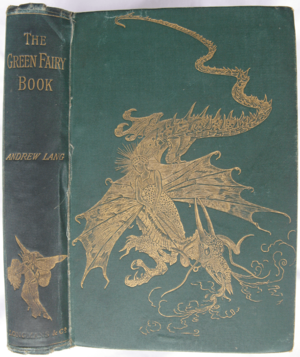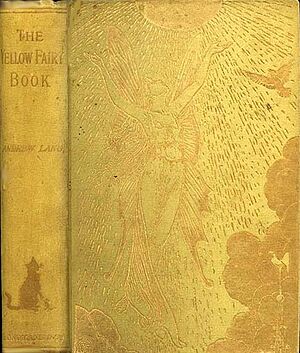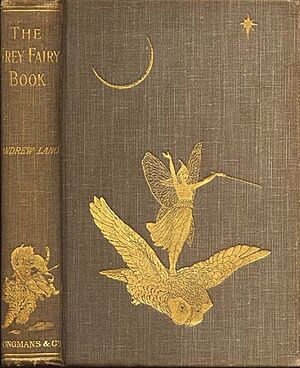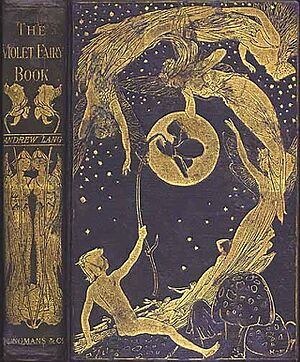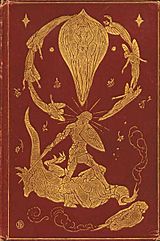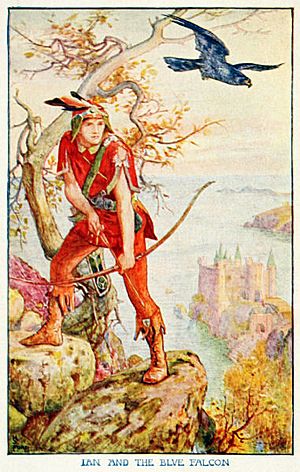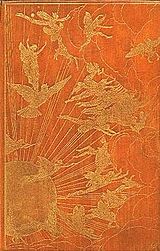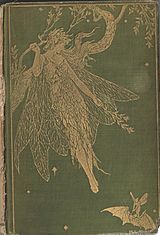Lang's Fairy Books facts for kids

Rumpelstiltskin from The Blue Fairy Book, illustrated by Henry J. Ford
|
|
|
The Blue Fairy Book The Red Fairy Book The Blue Poetry Book The Green Fairy Book The True Story Book The Yellow Fairy Book The Red True Story Book The Animal Story Book The Pink Fairy Book The Arabian Nights' Entertainments The Red Book of Animal Stories The Grey Fairy Book The Violet Fairy Book The Book of Romance The Crimson Fairy Book The Brown Fairy Book The Red Romance Book The Orange Fairy Book The Olive Fairy Book The Red Book of Heroes The Lilac Fairy Book The All Sorts of Stories Book The Book of Saints and Heroes The Strange Story Book |
|
| Author | Andrew Lang Nora Lang |
|---|---|
| Illustrator | Henry J. Ford (and others) |
| Country | United Kingdom |
| Language | English |
| Genre | Fairy tales |
| Published | 1889–1913 |
| No. of books | 25 |
The Langs' Fairy Books is a famous collection of 25 books filled with exciting stories. These books were published between 1889 and 1913. They were put together by Andrew Lang and his wife, Leonora Blanche Alleyne, also known as Nora Lang.
The most well-known books in the series are the 12 collections of fairy tales. These are often called Andrew Lang's "Coloured" Fairy Books because each one has a different color in its title. In total, the series contains 798 stories. There are also 153 poems in The Blue Poetry Book.
Andrew Lang (1844–1912) was a Scottish writer. He was a poet, novelist, and literary critic. He started the series and wrote introductions for all the books. His wife, Nora Lang (1851–1933), took over editing the series in the 1890s. She and other translators did a lot of the work. They translated and retold many of the stories. The introductions in the books often mention her important contributions.
The 12 Coloured Fairy Books have beautiful pictures. Most of these were drawn by Henry Justice Ford. Other artists like G. P. Jacomb-Hood, Lancelot Speed, and A. Wallis Mills also helped.
Contents
- The Famous Fairy Books
- The Books in the Series
- The Blue Fairy Book (1889)
- The Red Fairy Book (1890)
- The Blue Poetry Book (1891)
- The Green Fairy Book (1892)
- The True Story Book (1893)
- The Yellow Fairy Book (1894)
- The Red True Story Book (1895)
- The Animal Story Book (1896)
- The Pink Fairy Book (1897)
- The Arabian Nights' Entertainments (1898)
- The Red Book of Animal Stories (1899)
- The Grey Fairy Book (1900)
- The Violet Fairy Book (1901)
- The Book of Romance (1902)
- The Crimson Fairy Book (1903)
- The Brown Fairy Book (1904)
- The Red Romance Book (1905)
- The Orange Fairy Book (1906)
- The Olive Fairy Book (1907)
- The Book of Princes and Princesses (1908)
- The Red Book of Heroes (1909)
- The Lilac Fairy Book (1910)
- The All Sorts of Stories Book (1911)
- The Book of Saints and Heroes (1912)
- The Strange Story Book (1913)
- Images for kids
The Famous Fairy Books
How the Books Started
The most famous books in the series are the 12 Fairy Books. Each book is known by its unique color. The Langs did not collect these fairy tales directly from people telling them. Instead, they gathered stories from many different written sources. They were one of the first to collect tales from so many places.
These collections had a huge impact. Many of the tales appeared in English for the first time thanks to the Langs. Andrew chose the stories for the first four books. After that, Nora took charge of the series. She and other translators did a lot of the work. They translated and retold the actual stories.
Andrew Lang wanted to publish fairy tales for a special reason. He loved the folk and fairy tales from his home in Scotland. At that time, British fairy tale collections were rare. Lang felt that critics thought fairy tales were bad for young readers. These critics believed the stories were too unreal or scary. Lang's books helped change this idea over time.
Why the Books Were So Popular
The series became incredibly popular. This was partly because Lang was a well-known folklorist. The colorful, matching books also made them very appealing. The series greatly influenced children's literature. It made fairy tales much more popular than stories about everyday life.
Other writers were inspired by the Langs' success. For example, Joseph Jacobs created English Fairy Tales (1890). American writers like Clifton Johnson also made similar collections. These included The Oak-Tree Fairy Book (1905).
Lang often explained that the stories he shared were very old. He believed new fairy tales were not as good. He wrote that new stories often tried to teach lessons or be funny, but failed. He said real fairies never preach or use slang. He thought new stories were often just dreams.
The collections were made especially for children. Some parts of the stories were changed to be more suitable for young readers. Lang explained this in his introductions.
The Books in the Series
Here are some of the books in The Langs' Fairy Books series:
The Blue Fairy Book (1889)
This was the first book in the series. It sold 5,000 copies when it first came out. It brought together many famous tales. These included stories from the Brothers Grimm and Arabian Nights. It also had Norwegian fairy tales. Because it was the first, it has some of the best-known stories.
- "The Bronze Ring"
- "Prince Hyacinth and the Dear Little Princess"
- "East of the Sun and West of the Moon"
- "The Yellow Dwarf"
- "Little Red Riding Hood"
- "The Sleeping Beauty in the Wood"
- "Cinderella or the Little Glass Slipper"
- "Aladdin and the Wonderful Lamp"
- "The Tale of a Youth Who Set Out to Learn What Fear Was"
- "Rumpelstiltskin"
- "Beauty and the Beast"
- "The Master Maid"
- "Why the Sea Is Salt"
- "The Master Cat or Puss in Boots"
- "Felicia and the Pot of Pinks"
- "The White Cat"
- "The Water-lily. The Gold-spinners"
- "The Terrible Head"
- "The Story of Pretty Goldilocks"
- "The History of Whittington"
- "The Wonderful Sheep"
- "Little Thumb"
- "The Forty Thieves"
- "Hansel and Gretel"
- "Snow-White and Rose-Red"
- "The Goose-girl"
- "Toads and Diamonds"
- "Prince Darling"
- "Blue Beard"
- "Trusty John"
- "The Brave Little Tailor"
- "A Voyage to Lilliput"
- "The Princess on the Glass Hill"
- "The Story of Prince Ahmed and the Fairy Paribanou"
- "The History of Jack the Giant-killer"
- "The Black Bull of Norroway"
- "The Red Etin"
The Red Fairy Book (1890)
This book came out in 1890 and had 10,000 copies in its first print. It includes tales from France, Russia, Denmark, and Romania. It also features stories from Norse mythology.
- "The Twelve Dancing Princesses"
- "The Princess Mayblossom"
- "Soria Moria Castle"
- "The Death of Koschei the Deathless"
- "The Black Thief and Knight of the Glen"
- "The Master Thief"
- "Brother and Sister"
- "Princess Rosette"
- "The Enchanted Pig"
- "The Norka"
- "The Wonderful Birch"
- "Jack and the Beanstalk"
- "The Little Good Mouse"
- "Graciosa and Percinet"
- "The Three Princesses of Whiteland"
- "The Voice of Death"
- "The Six Sillies"
- "Kari Woodengown"
- "Drakestail"
- "The Ratcatcher"
- "The True History of Little Goldenhood"
- "The Golden Branch"
- "The Three Dwarfs"
- "Dapplegrim"
- "The Enchanted Canary"
- "The Twelve Brothers"
- "Rapunzel"
- "The Nettle Spinner"
- "Farmer Weatherbeard"
- "Mother Holle"
- "Minnikin"
- "Bushy Bride"
- "Snowdrop"
- "The Golden Goose"
- "The Seven Foals"
- "The Marvellous Musician"
- "The Story of Sigurd"
The Blue Poetry Book (1891)
This book is different from the others. It contains 153 poems. These poems are by famous British and American poets.
The Green Fairy Book (1892)
Andrew Lang thought this would be the last fairy book. But the books were so popular that more were demanded! This book includes stories from Spain and China.
- "The Blue Bird"
- "The Half-Chick"
- "The Story of Caliph Stork"
- "The Enchanted Watch"
- "Rosanella"
- "Sylvain and Jocosa"
- "Fairy Gifts"
- "Prince Narcissus and the Princess Potentilla"
- "Prince Featherhead and the Princess Celandine"
- "The Three Little Pigs"
- "Heart of Ice"
- "The Enchanted Ring"
- "The Snuff-box"
- "The Golden Blackbird"
- "The Little Soldier"
- "The Magic Swan"
- "The Dirty Shepherdess"
- "The Enchanted Snake"
- "The Biter Bit"
- "King Kojata"
- "Prince Fickle and Fair Helena"
- "Puddocky"
- "The Story of Hok Lee and the Dwarfs"
- "The Story of the Three Bears"
- "Prince Vivien and the Princess Placida"
- "Little One-eye, Little Two-eyes, and Little Three-eyes"
- "Jorinde and Joringel"
- "Allerleirauh; or, the Many-furred Creature"
- "The Twelve Huntsmen"
- "Spindle, Shuttle, and Needle"
- "The Crystal Coffin"
- "The Three Snake-leaves"
- "The Riddle"
- "Jack my Hedgehog"
- "The Golden Lads"
- "The White Snake"
- "The Story of a Clever Tailor"
- "The Golden Mermaid"
- "The War of the Wolf and the Fox"
- "The Story of the Fisherman and his Wife"
- "The Three Musicians"
- "The Three Dogs"
The True Story Book (1893)
This book contains 24 true stories. Most of them are from European history. They tell about real events and people.
The Yellow Fairy Book (1894)
This book had 15,000 copies printed at first. It gathers tales from all over the world. Many stories by Hans Christian Andersen are in this collection.
- "Cat and Mouse in Partnership"
- "The Six Swans"
- "The Dragon of the North"
- "Story of the Emperor's New Clothes"
- "The Golden Crab"
- "The Iron Stove"
- "The Dragon and his Grandmother"
- "The Donkey Cabbage"
- "The Little Green Frog"
- "The Seven-headed Serpent"
- "The Grateful Beasts"
- "The Giants and the Herd-boy"
- "The Invisible Prince"
- "The Crow"
- "How Six Men Travelled Through the Wide World"
- "The Wizard King"
- "The Nixy"
- "The Glass Mountain"
- "Alphege, or the Green Monkey"
- "Fairer-than-a-Fairy"
- "The Three Brothers"
- "The Boy and the Wolves, or the Broken Promise"
- "The Glass Axe"
- "The Dead Wife"
- "In the Land of Souls"
- "The White Duck"
- "The Witch and Her Servants"
- "The Magic Ring"
- "The Flower Queen's Daughter"
- "The Flying Ship"
- "The Snow-daughter and the Fire-son"
- "The Story of King Frost"
- "The Death of the Sun-hero"
- "The Witch"
- "The Hazel-nut Child"
- "The Story of Big Klaus and Little Klaus"
- "Prince Ring"
- "The Swineherd"
- "How to tell a True Princess"
- "The Blue Mountains"
- "The Tinder-box"
- "The Witch in the Stone Boat"
- "Thumbelina"
- "The Nightingale"
- "Hermod and Hadvor"
- "The Steadfast Tin-soldier"
- "Blockhead Hans"
- "A Story about a Darning-needle"
The Red True Story Book (1895)
This book has 30 true stories. Many are from European history. It includes the life of Joan of Arc and the Jacobite uprising of 1745.
The Animal Story Book (1896)
This book features 65 stories about animals. Some are about how animals live in the wild. Others are about pets or amazing wild animals. Many stories are from the writer Alexandre Dumas.
The Pink Fairy Book (1897)
This book contains 41 tales. They come from Japan, Scandinavia, and Sicily.
- "The Cat's Elopement"
- "How the Dragon Was Tricked"
- "The Goblin and the Grocer"
- "The House in the Wood"
- "Urashimataro and the Turtle"
- "The Slaying of the Tanuki"
- "The Flying Trunk"
- "The Snow Man"
- "The Shirt-Collar"
- "The Princess in the Chest"
- "The Three Brothers"
- "The Snow-queen"
- "The Fir-Tree"
- "Hans, the Mermaid's Son"
- "Peter Bull"
- "The Bird 'Grip'"
- "Snowflake"
- "I Know What I Have Learned"
- "The Cunning Shoemaker"
- "The King Who Would Have a Beautiful Wife"
- "Catherine and Her Destiny"
- "How the Hermit Helped to Win the King's Daughter"
- "The Water of Life"
- "The Wounded Lion"
- "The Man Without a Heart"
- "The Two Brothers"
- "Master and Pupil"
- "The Golden Lion"
- "The Sprig of Rosemary"
- "The White Dove"
- "The Troll's Daughter"
- "Esben and the Witch"
- "Princess Minon-Minette"
- "Maiden Bright-eye"
- "The Merry Wives"
- "King Lindworm"
- "The Jackal, the Dove, and the Panther"
- "The Little Hare"
- "The Sparrow with the Slit Tongue"
- "The Story of Ciccu"
- "Don Giovanni de la Fortuna"
The Arabian Nights' Entertainments (1898)
This book has 34 stories from the famous Arabian Nights. They are adapted for children. The story of Aladdin is in this book, as well as in The Blue Fairy Book.
- "The Arabian Nights"
- "The Story of the Merchant and the Genius"
- "The Story of the First Old Man and of the Hind"
- "The Story of the Second Old Man, and of the Two Black Dogs"
- "The Story of the Fisherman"
- "The Story of the Greek King and the Physician Douban"
- "The Story of the Husband and the Parrot"
- "The Story of the Vizir Who Was Punished"
- "The Story of the Young King of the Black Isles"
- "The Story of the Three Calendars, Sons of Kings, and of Five Ladies of Bagdad"
- "The Story of the First Calendar, Son of a King"
- "The Story of the Envious Man and of Him Who Was Envied"
- "The Story of the Second Calendar, Son of a King"
- "The Story of the Third Calendar, Son of a King"
- "The Seven Voyages of Sindbad the Sailor"
- "First Voyage"
- "Second Voyage"
- "Third Voyage"
- "Fourth Voyage"
- "Fifth Voyage"
- "Sixth Voyage"
- "Seventh and Last Voyage"
- "The Little Hunchback"
- "The Story of the Barber's Fifth Brother"
- "The Story of the Barber's Sixth Brother"
- "The Adventures of Prince Camaralzaman and the Princess Badoura"
- "Noureddin and the Fair Persian"
- "Aladdin and the Wonderful Lamp"
- "The Adventures of Haroun-al-Raschid, Caliph of Bagdad"
- "The Story of the Blind Baba-Abdalla"
- "The Story of Sidi-Nouman"
- "The Story of Ali Cogia, Merchant of Bagdad"
- "The Enchanted Horse"
- "The Story of Two Sisters Who Were Jealous of Their Younger Sister"
The Red Book of Animal Stories (1899)
This book has 46 stories about real and mythical animals. Some stories describe how animals live in the wild. Others are about pets or hunting adventures.
The Grey Fairy Book (1900)
This book contains 35 stories. Many come from old oral traditions. Others are from French, German, and Italian collections.
- "Donkey Skin"
- "The Goblin Pony"
- "An Impossible Enchantment"
- "The Story of Dschemil and Dschemila"
- "Janni and the Draken"
- "The Partnership of the Thief and the Liar"
- "Fortunatus and his Purse"
- "The Goat-faced Girl"
- "What came of picking Flowers"
- "The Story of Bensurdatu"
- "The Magician's Horse"
- "The Little Gray Man"
- "Herr Lazarus and the Draken"
- "The Story of the Queen of the Flowery Isles"
- "Udea and her Seven Brothers"
- "The White Wolf"
- "Mohammed with the Magic Finger"
- "Bobino"
- "The Dog and the Sparrow"
- "The Story of the Three Sons of Hali"
- "The Story of the Fair Circassians"
- "The Jackal and the Spring"
- "The Bear"
- "The Sunchild"
- "The Daughter of Buk Ettemsuch"
- "Laughing Eye and Weeping Eye, or the Limping Fox"
- "The Unlooked for Prince"
- "The Simpleton"
- "The Street Musicians"
- "The Twin Brothers"
- "Cannetella"
- "The Ogre"
- "A Fairy's Blunder"
- "Long, Broad, and Quickeye"
- "Prunella"
The Violet Fairy Book (1901)
This book has 35 stories from many places. These include Romania, Japan, Serbia, Lithuania, Africa, Portugal, and Russia. The tales feature haunted forests, magic dogs, and clever people outsmarting dragons.
- "A Tale Of the Tontlawald"
- "The Finest Liar in the World"
- "The Story of Three Wonderful Beggars"
- "Schippeitaro"
- "The Three Princes and their Beasts"
- "The Goat's Ears of the Emperor Trojan"
- "The Nine Pea-hens and the Golden Apples"
- "The Lute Player"
- "The Grateful Prince"
- "The Child who came from an Egg"
- "Stan Bolovan"
- "The Two Frogs"
- "The Story of a Gazelle"
- "How a Fish swam in the Air and a Hare in the Water"
- "Two in a Sack"
- "The Envious Neighbour"
- "The Fairy of the Dawn"
- "The Enchanted Knife"
- "Jesper Who Herded the Hares"
- "The Underground Workers"
- "The History of Dwarf Long Nose"
- "The Nunda, Eater of People"
- "The Story of Hassebu"
- "The Maiden with the Wooden Helmet"
- "The Monkey and the Jelly-fish"
- "The Headless Dwarfs"
- "The Young Man Who Would Have His Eyes Opened"
- "The Boys with the Golden Stars"
- "The Frog"
- "The Princess Who Was Hidden Underground"
- "The Girl Who Pretended to be a Boy"
- "The Story of Halfman"
- "The Prince Who Wanted to See the World"
- "Virgilius the Sorcerer"
- "Mogarzea and his Son"
The Book of Romance (1902)
This book contains 19 stories. They are adapted for children from old tales of chivalry. These include stories about King Arthur, Charlemagne, and Robin Hood.
- "The Drawing of the Sword"
- "The Questing Beast"
- "The Sword Excalibur"
- "The Story of Sir Balin"
- "How the Round Table began"
- "The Passing of Merlin"
- "How Morgan Le Fay tried to kill King Arthur"
- "What Beaumains asked of the King"
- "The Quest of the Holy Graal"
- "The Fight for the Queen"
- "The Fair Maid of Astolat"
- "Lancelot and Guenevere"
- "The End of it All"
- "The Battle of Roncevalles"
- "The Pursuit of Diarmid"
- "Some Adventures of William Short Nose"
- "Wayland the Smith"
- "The Story of Robin Hood"
- "The Story of Grettir the Strong"
The Crimson Fairy Book (1903)
These 36 stories come from many different places. These include Hungary, Russia, Finland, Iceland, and Tunisia.
- "Lovely Ilonka"
- "Lucky Luck"
- "The Hairy Man"
- "To Your Good Health!"
- "The Story of the Seven Simons"
- "The Language of Beasts"
- "The Boy Who Could Keep a Secret"
- "The Prince and the Dragon"
- "Little Wildrose"
- "Tiidu the Piper"
- "Paperarello"
- "The Gifts of the Magician"
- "The Strong Prince"
- "The Treasure Seeker"
- "The Cottager and his Cat"
- "The Prince Who Would Seek Immortality"
- "The Stone-cutter"
- "The Gold-bearded Man"
- "Tritill, Litill, and the Birds"
- "The Three Robes"
- "The Six Hungry Beasts"
- "How the Beggar Boy turned into Count Piro"
- "The Rogue and the Herdsman"
- "Eisenkopf"
- "The Death of Abu Nowas and of his Wife"
- "Motikatika"
- "Niels and the Giants"
- "Shepherd Paul"
- "How the Wicked Tanuki was Punished"
- "The Crab and the Monkey"
- "The Horse Gullfaxi and the Sword Gunnfoder"
- "The Story of the Sham Prince, or the Ambitious Tailor"
- "The Colony of Cats"
- "How to find out a True Friend"
- "Clever Maria"
- "The Magic Kettle"
The Brown Fairy Book (1904)
This book has stories from many cultures. It includes tales from American Indians, Australian Bushmen, and African Kaffirs. It also has stories from Persia, Lapland, Brazil, and India.
- "What the Rose did to the Cypress"
- "Ball-Carrier and the Bad One"
- "How Ball-Carrier finished his Task"
- "The Bunyip"
- "Father Grumbler"
- "The Story of the Yara"
- "The Cunning Hare"
- "The Turtle and his Bride"
- "How Geirald the Coward was Punished"
- "Habogi"
- "How the Little Brother set Free his Big Brothers"
- "The Sacred Milk of Koumongoe"
- "The Wicked Wolverine"
- "The Husband of the Rat's Daughter"
- "The Mermaid and the Boy"
- "Pivi and Kabo"
- "The Elf Maiden"
- "How Some Wild Animals became Tame Ones"
- "Fortune and the Wood-Cutter"
- "The Enchanted Head"
- "The Sister of the Sun"
- "The Prince and the Three Fates"
- "The Fox and the Lapp"
- "Kisa the Cat"
- "The Lion and the Cat"
- "Which was the Foolishest?"
- "Asmund and Signy"
- "Rubezahl"
- "Story of the King who would be Stronger than Fate"
- "Story of Wali Dad the Simple-hearted"
- "Tale of a Tortoise and of a Mischievous Monkey"
- "The Knights of the Fish"
The Red Romance Book (1905)
This book has 29 stories. They are adapted for children from old tales of chivalry. It includes stories about Don Quixote, Charlemagne, and Guy of Warwick.
The Orange Fairy Book (1906)
This book includes 33 tales. They come from Jutland, Rhodesia, Uganda, and other European traditions.
- "The Story of the Hero Makoma"
- "The Magic Mirror"
- "Story of the King who would see Paradise"
- "How Isuro the Rabbit tricked Gudu"
- "Ian, the Soldier's Son"
- "The Fox and the Wolf"
- "How Ian Direach got the Blue Falcon"
- "The Ugly Duckling"
- "The Two Caskets"
- "The Goldsmith's Fortune"
- "The Enchanted Wreath"
- "The Foolish Weaver"
- "The Clever Cat"
- "The Story of Manus Pinkel the Thief"
- "The Adventures of a Jackal"
- "The Adventures of the Jackal's Eldest Son"
- "The Adventures of the Younger Son of the Jackal"
- "The Three Treasures of the Giants"
- "The Rover of the Plain"
- "The White Doe"
- "The Girl-Fish"
- "The Owl and the Eagle"
- "The Frog and the Lion Fairy"
- "The Adventures of Covan the Brown-haired"
- "The Princess Bella-Flor"
- "The Bird of Truth"
- "The Mink and the Wolf"
- "Adventures of an Indian Brave"
- "How the Stalos were Tricked"
- "Andras Baive"
- "The White Slipper"
- "The Magic Book"
The Olive Fairy Book (1907)
This book includes unique stories. They come from Turkey, India, Denmark, Armenia, and Sudan.
- "Madschun"
- "The Blue Parrot"
- "Geirlug The King's Daughter"
- "The Story of Little King Loc"
- "A Long-Bow Story"
- "Jackal or Tiger?"
- "The Comb and the Collar"
- "The Thanksgiving of the Wazir"
- "Samba the Coward"
- "Kupti and Imani"
- "The Strange Adventures of Little Maia"
- "Diamond Cut Diamond"
- "The Green Knight"
- "The Five Wise Words of the Guru"
- "The Golden-Headed Fish"
- "Dorani"
- "The Satin Surgeon"
- "The Billy Goat and the King"
- "The Story of Zoulvisia"
- "Grasp All, Lose All"
- "The Fate of the Turtle"
- "The Snake Prince"
- "The Prince and the Princess in the Forest"
- "The Clever Weaver"
- "The Boy Who Found Fear At Last"
- "He Wins Who Waits"
- "The Steel Cane"
- "The Punishment of the Fairy Gangana"
- "The Silent Princess"
The Book of Princes and Princesses (1908)
This book was written by "Mrs. Lang" (Nora Lang). It has 14 stories about the childhoods of European rulers. These include Napoleon and Elizabeth I.
The Red Book of Heroes (1909)
This book was also written by "Mrs. Lang". It contains 12 true stories about inspiring people. These heroes include Hannibal and Florence Nightingale.
The Lilac Fairy Book (1910)
This book has stories from Portugal, Ireland, Wales, and other places around the world.
- "The Shifty Lad"
- "The False Prince and the True"
- "The Jogi's Punishment"
- "The Heart of a Monkey"
- "The Fairy Nurse"
- "A Lost Paradise"
- "How Brave Walter Hunted Wolves"
- "The King of the Waterfalls"
- "A French Puck"
- "The Three Crowns"
- "The Story of a Very Bad Boy"
- "The Brown Bear of Norway"
- "Little Lasse"
- "Moti"
- "The Enchanted Deer"
- "A Fish Story"
- "The Wonderful Tune"
- "The Rich Brother and the Poor Brother"
- "The One-Handed Girl"
- "The Bones of Djulung"
- "The Sea King's Gift"
- "The Raspberry Worm"
- "The Stones of Plouhinec"
- "The Castle of Kerglas"
- "The Battle of the Birds"
- "The Lady of the Fountain"
- "The Four Gifts"
- "The Groac'h of the Isle of Lok"
- "The Escape of the Mouse"
- "The Believing Husbands"
- "The Hoodie-Crow"
- "The Brownie of the Lake"
- "The Winning of Olwen"
The All Sorts of Stories Book (1911)
This book was written by "Mrs. Lang". It has 30 stories on many different topics. These include true stories, Greek myths, and tales from famous writers like Alexandre Dumas.
The Book of Saints and Heroes (1912)
This book was written by "Mrs. Lang". It contains 23 stories about saints. Most are true stories, but some legends are also included.
The Strange Story Book (1913)
This book was published after Andrew Lang passed away. Nora Lang wrote the introduction. It has 34 stories on various subjects. These include ghost stories, Native American legends, and true stories.
Images for kids



